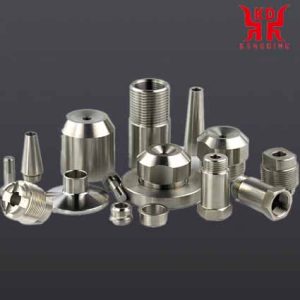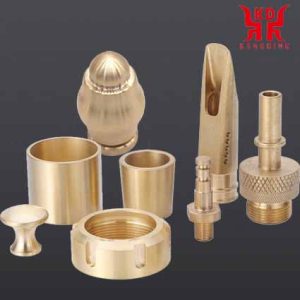catégories de produits
Mots clés du produit
Services de fraisage CNC en Chine
Le fraisage CNC est un processus de fabrication dans lequel un logiciel informatique préprogrammé dicte le mouvement des outils et des machines d'usine.. Prototypes rapides ou pièces de production – Nous disposons des options de fraisage CNC adaptées à vos besoins de production de pièces en plastique ou en métal.. La méthode peut être utilisée pour contrôler un certain nombre de machines complexes, des rectifieuses et tours aux fraiseuses et défonceuses. Avec fraisage CNC, les tâches de découpe tridimensionnelles peuvent être effectuées dans un seul ensemble d'invites.

CNC finishing of aluminum alloy parts
Le fraisage CNC, un rôle essentiel dans la fabrication moderne.
Qu'est-ce que le fraisage CNC? Comment joue-t-il un rôle dans la fabrication, et que fait le machiniste CNC?
Le fraisage CNC est un processus de fabrication dans lequel un logiciel informatique préprogrammé dicte le mouvement des outils et des machines d'usine.. Prototypes rapides ou pièces de production – Nous avons les bonnes options de fraisage CNC pour vos besoins de production de pièces en plastique ou en métal.. La méthode peut être utilisée pour contrôler un certain nombre de machines complexes, des rectifieuses et tours aux fraiseuses et défonceuses. Avec fraisage CNC, les tâches de découpe tridimensionnelles peuvent être effectuées dans un seul ensemble d'invites.
Abréviation de « Contrôle numérique par ordinateur », le processus CNC contraste avec les limites du contrôle manuel, qui nécessite que les opérateurs en direct interrogent et guident les commandes des outils d'usinage via des leviers, boutons et roues. Au spectateur, un système CNC peut ressembler à un ensemble normal de composants informatiques, mais les logiciels et les consoles utilisés dans le fraisage CNC le distinguent de toutes les autres formes de calcul..

Avant le fraisage NC et CNC
L'usinage CN et plus tard CNC ont permis de contrôler des machines-outils sans la forte proportion d'interventions manuelles qui devaient avoir lieu jusqu'alors pour usiner une pièce..
Par exemple, avant l'usinage CNC et NC, le perçage d'un tube se faisait en plaçant le tube dans la presse de la machine outil pour le maintenir, sélectionner dans cette machine la vitesse de rotation de la perceuse (généralement avec des poulies à courroie) et activation de la broche. Ces actions comportaient une forte proportion de manipulations manuelles (placer le foret sur l'axe, activation de l'axe, placer la pièce sous la perceuse, Usinage du trou et arrêt de l'axe), quelque chose qui ne posait pas de problèmes majeurs avec de petites quantités , mais comme il fallait usiner un plus grand nombre de pièces et réaliser des actions d'usinage plus complexes, the probability of fatigue of the person due to the tedium of the operation increased, and therefore decreased productivity and increased the margin of error.
NC machining represented a breakthrough in this sense because it allowed the machine tool to be controlled by means of a perforated belt containing the movements of the machine in relation to the coordinate axes that specified the movement of the cutting tool. De cette façon, the intervention of the person was not needed at each step, they could do other tasks, and productivity was greatly increased.
Before numerical control, machining processes had a high component of manual manipulation. Today some isolated operations are carried out manually, with few parts.
Subsequently, ce contrôle est passé d'un ruban perforé à un ordinateur, y compris le placement du foret sur l'arbre, Activation, etc.. Cela présentait plusieurs avantages.
Principaux avantages du fraisage CNC
Automatisation améliorée par rapport à la commande numérique sans ordinateur: Cela signifie que l'intervention de la personne à chaque étape peut être réduite, voire supprimée., bien qu'un certain type d'action manuelle ait toujours lieu pour des tâches spécifiques, comme la réparation et le prototypage. Cela permet une production plus élevée en même temps, puisque les machines CNC sont capables de fonctionner 24 heures par jour.
Plus grande précision et cohérence des pièces obtenues: Les machines CNC d’aujourd’hui ont des spécifications étonnantes en matière de précision et de répétabilité, avec deux, dix, soit un millier de pièces identiques facilement réalisables une fois le programme vérifié. That was critical in mass production.
Greater flexibility: Being machine tools controlled by a computer program, carrying out a new machining that only contains a few small changes compared to a previous job only requires loading a saved project, making certain changes and saving it separately, as in any other software. This allows quick changes and adaptation to any type of part, and eliminates most prototypes.
Greater security: to have a minimal interaction of the operator with the machine in most of the movements. Previously, when intervening in actions such as changing heads, loading material, stopping a movement, etc., there were more chances of having accidents.
Main challenges of CNC Milling
High operating costs: Although CNC machines reduce the number of manual workers required in a manufacturing plant, the machines are more expensive to operate. Cependant, the costs associated with running the machines are gradually decreasing.
Training need: Initially, the generalization of CNC Milling led to high unemployment, as the need for manual workers was reduced. Cependant, with proper training, this system creates new opportunities for specialized employment. as it requires CNC machine tool operators, programmers, maintenance personnel, as well as machine tool manufacturing engineers and technicians and trainers to teach its operation.

CNC finishing parts

Finition CNC de pièces en acier inoxydable

5-pièces de finition d'axe
How CNC Milling Works
Broadly speaking, CNC Milling allows doing practically everything that was previously done manually: placing the drill bit on the axis, activating it, placing the part to be machined on the machine, machining it and turning off the axis. Once the machine tool is configured by CNC and put to work, it requires little intervention from the operators. You can even automate the part loading process.
Cependant, the task of the operator is still required to make measurement checks and adjustments to keep the CNC machine working properly.
Movement control
Any CNC Milling machine tool allows programming two or more directions of movement (axes, which can be linear-along a straight line- or rotary-along a circular path-). Common linear axis names are X, Oui, et Z. Common rotary axis names are A, B, and C. The more axes the machine has, the more complex it is. In drilling, the three linear axes would position the tool over the hole to be machined in the part on the X and Y axes and would machine the hole with the third Z axis.
Programmable accessories
Bien que la fonction fondamentale de toutes les fraiseuses CNC soit de contrôler le mouvement en fonction des axes, ce qui donne vraiment de la valeur à chaque machine, ce n'est pas de déplacer la pièce sur deux axes ou plus. mais plutôt les accessoires programmables qu'il embarque, ce qui leur fait multiplier leurs fonctions.
Par exemple, un centre d'usinage peut être équipé d'un chargeur d'outils automatique pour changer l'instrument de coupe sans intervention de l'opérateur. et si nécessaire, vous pouvez choisir l'outil et le placer automatiquement sur la broche pour l'usinage, ou programmation de la vitesse des axes et de l'activation de la broche, ou le liquide de refroidissement pour lubrifier et refroidir la pièce qui peut être allumée et éteinte depuis le cycle de la machine.

Finition CNC de pièces en cuivre
Avec le système de fraisage CNC, une pièce est usinée selon les étapes suivantes:
1) Design of the conceived part: use CAD software to create a 2D or 3D model of the part.
2) CNC programming: use CAM software to convert CAD model to g-code. G-Code is the language used to program CNC machines, which can be edited from a normal text manager (Notepad, Word) or a specialized program.
3) CNC machine setup: In this step, the machine is setup by clamping, suitable tools and G-code editing program (by DNC system), and the tool data is loaded to prepare the machine to machine the part. The operator will also tell the machine where the zero point is to start.
4) CNC Milling of the part: with all the above ready, it is time to start machining the part.
CNC Milling allows doing practically everything that was previously done manually: placing the drill bit on the axis, activating it, placing the part to be machined on the machine, machining it and turning off the axis.
Metal industry and CNC Milling
CNC Milling has revolutionized the metal industry, decisively influencing its economic potential, with higher production at lower cost. Basically we can distinguish three large groups within the metal industry that make CNC Milling machine tools their main work system:
Metal fabrication industry: Thin plates such as steel plates are required in many industries for various purposes, and such plates are machined in the manufacturing industry. generally with CNC machines that carry out various operations such as cutting, flame or plasma cutting, perforation, laser cutting, contouring and welding and many other applications.
This industry was one of the most used manual machines decades ago (punching machines, disc cutting machines, presses, etc.) but today the CNC versions of these same machines are fully extended and are used in a majority way.

Medical implant titanium alloy cavity
Prototypes rapides ou pièces de production - Nous avons les bonnes options de fraisage CNC pour vos besoins de production de pièces en plastique ou en métal..
Wide range of materials
Meet the Tightest Tolerances
Machining parts directly from 3D CAD models
Standard delivery time between 1 et 2 weeks, depending on the order
Delivery times may be shorter (2 à 5 jours ouvrables), depending on available capacity
Tolerances for the size of the details:
Standard: +/- 0.005
Minimum: +/- 0.002 for metal and +/- 0.003 for plastic
Tolerances for hole diameter:
Standard: +/- 0.005
Minimum: +/- 0.001 for metal and +/- 0.002 for plastic
Tolerances for flatness, eccentricity, cylindricity, perpendicularity and other geometries:
Standard: +/- 0.005
Minimum: +/- 0.001, depending on geometry
The above tolerances do not apply when machining welded assemblies or plates less than 1/4 "thick and greater than 20" thick, ou 1/8 "thick with more than 10" longueur. In these cases, the MFG team will need to review the tolerances.
CNC Milling is a subtractive manufacturing process whereby material is trimmed from the origin to create a finished component. Our standard surface finish is 63 à 125 Rms. Cependant, we can grind or polish the part to between 4 et 8 Rms.
Shot blasting
Electropolished
Traitement thermique
Sablage
Polissage à la vapeur
Avantage
Envoyez-nous vos données CAO 3D par email, indiquez les spécifications de votre projet et nous vous présenterons un devis personnalisé en moins de 24 heures
Tournant, tour à double revolver avec usinage rotatif, 3-, 4- et usinage 5 axes, atténuation du stress / traitement thermique, soudage, anodisation et revêtement en poudre
Pièces usinées CNC en aussi peu que 6-8 jours ouvrables (depending on geometry)
Des chefs de projet dédiés pour vous accompagner tout au long du processus
Contactez-nous
En attente de votre email, nous vous répondrons dans les 12 heures avec des informations précieuses dont vous aviez besoin.
 English
English العربية
العربية 中文(漢字)
中文(漢字) Čeština
Čeština Dansk
Dansk Nederlands
Nederlands Suomi
Suomi Français
Français Deutsch
Deutsch Italiano
Italiano 日本語
日本語 ಕನ್ನಡ
ಕನ್ನಡ 한국어
한국어 Português
Português Русский
Русский Slovenčina
Slovenčina Español
Español Svenska
Svenska Türkçe
Türkçe



